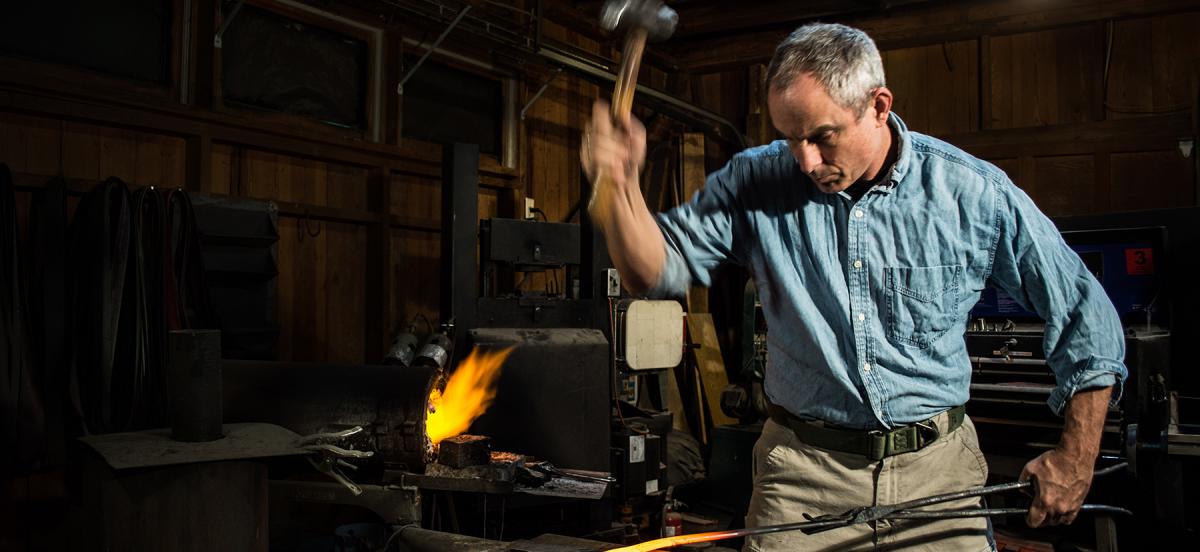Forging Swords and Stories: Walter Sorrells ’85

Details
Walter Sorrells ’85 makes sure his products are always looking sharp—both literally and figuratively.
Get into a conversation with Walter Sorrells ’85 and it won’t be too long before you become very, very jealous. “I’ve pretty much spent my entire adult life doing the same things I was interested in when I was 13 years old,” he says, and he’s not kidding.
Sorrells, who lives in Marietta, Ga., with his wife and son, has been a novelist since his mid-20s, publishing thrillers and mysteries under a variety of names (he won an Edgar Award in 2000 for Fulton County Blues); he has trained in various martial arts for more than two decades; he is a competitive pistol shooter (“I wear my Haverford baseball cap when I go shooting!”); and for more than a decade, he has been handcrafting elaborate knives and swords.
That pursuit began as an offshoot of Sorrells’ writing career, which has included the Sunny Childs detective series, written under the Ruth Birmingham pseudonym, and several young-adult mysteries under his own name (including Fake ID and Club Dread, both featuring the Chass Pureheart character). “I started making blades as research for a character I was going to write about who was a swordsmith,” he says. “The novel died, but the pursuit lived.”
The blades he makes run from the $145 Survivor knife to $10,000 custom swords. The handles and scabbards—carefully crafted from wood, copper, silk, or even buffalo horn—are what jump out in photos of his work, but it’s the steel itself that is the real focus of any individual piece.
Sorrells uses two approaches to making blades: a traditional Japanese method and a more modern one. The modern knives (mostly hunting and self-defense knives that he sells under the name Tactix Armory) are shaped on a belt grinder and heat-treated in a temperature-controlled furnace. The Japanese-style blades are a more complex endeavor, using a technique that goes back almost a thousand years.
“In the most extreme case, I actually smelt the steel from ore in a tiny little smelter, then forge-weld that steel together, refining it by folding and re-welding over and over until it has about a million layers,” he says. “At that point I forge it into the shape of a knife or sword, using a hammer and an anvil. Then I hand-grind it on an abrasive stone to its final shape.”
At that point, the blade still has to be hardened. “It requires the most ridiculous degree of meticulousness and ludicrous amounts of labor,” says Sorrells. The shaped blade has to be “partially coated with a clay material, heated to about 1,500 degrees Fahrenheit, and then quenched in water. This causes the edge to harden and the spine to stay soft, producing a very hard, yet shock-resistant blade. Then the blade is carefully polished—hours and hours and hours of a very complex process that brings out the features of the steel.”
It’s the kind of deep craft that has its own subculture, of which Sorrells is very much a part: In addition to making the blades, he creates and sells knife-making tutorial DVDs, and his YouTube channel has dozens of instructional videos, many with hundreds of thousands of views. (One, showing how to make a particular type of Japanese knife, has garnered more than 1.5 million views.)
A commission for just one Japanese-style sword can take Sorrells several months to complete. But that commission isn’t as simple as ordering from Etsy—like a good novelist, Sorrells wants to understand the character behind the commission.
His website has a three-minute video explaining how to commission a sword. He stresses that customers might come to him knowing a lot about blades and their history, but it’s fine to just have a general interest in a custom knife or sword. The important thing for him is to forge a connection with the buyer.
“Mainly I want to know why they want the blade,” he says. “Are they a collector? A martial artist? Will they use it? Will it be locked up in a safe somewhere or hung on a wall? That’s all important.”
If bespoke knives seem like out-of-time curios for a digital world, Sorrells, who has been carrying a knife ever since his father gave him his first pocketknife at age 8, thinks of blades as fundamental symbols. “The knife is humanity’s first tool,” he says. “There’s evidence that knife-making literally changed humanity—not just the things you could do with the tool, but the process of thinking about tools changed the way our ancestors’ brains worked. My belief is that carrying a tool with you is a kind of mute testimony to your own competence to handle life’s challenges.”



